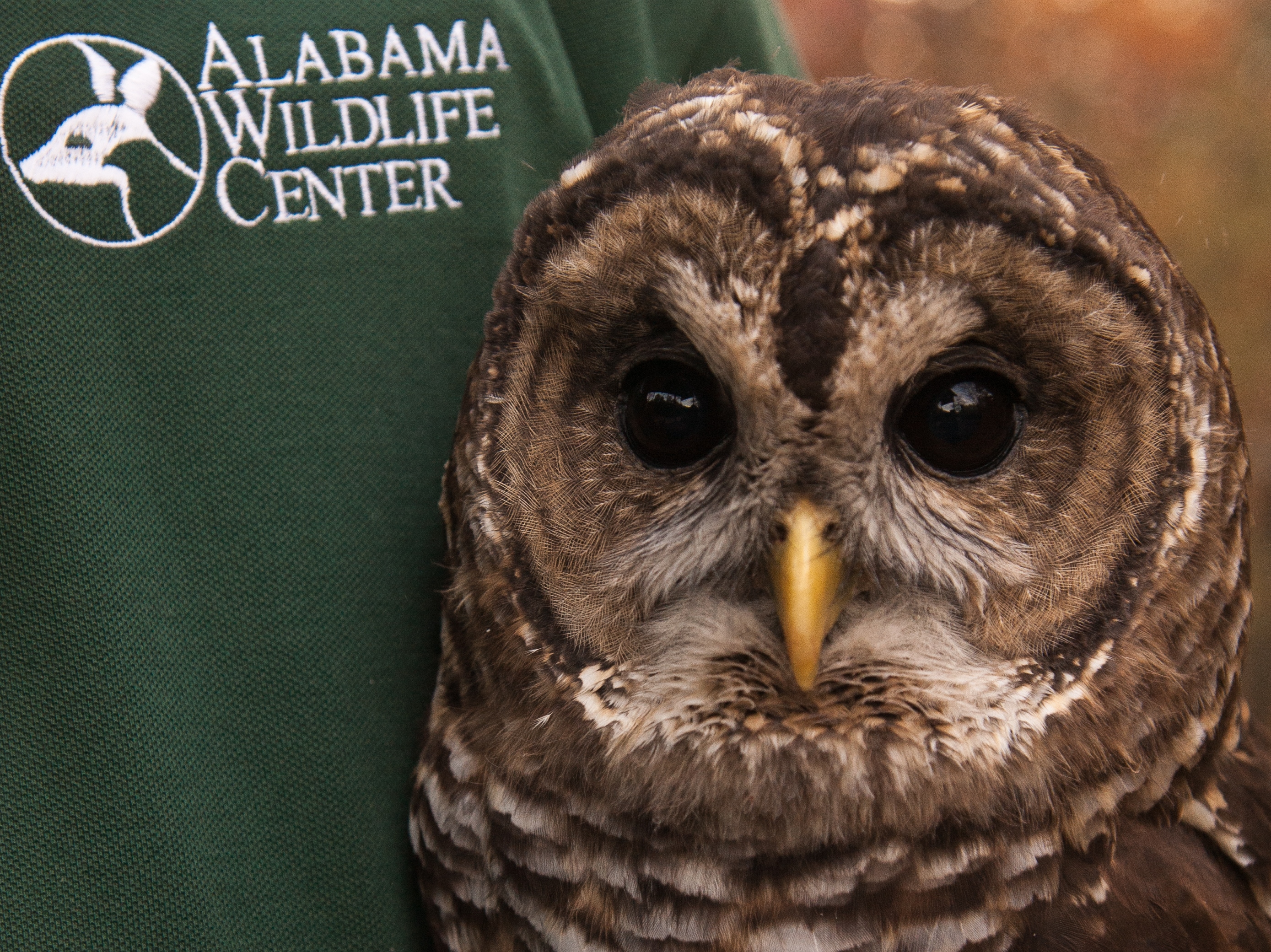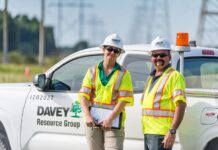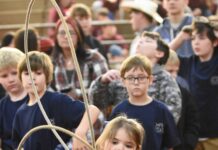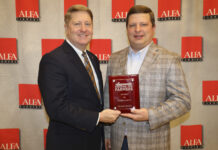PELHAM – Ever hear the haunting call of an owl on a dark night? That could be a barn owl, or maybe what your grandparents called a ‘hoot’ owl. Or maybe you’ve heard a sound that has been described as that of a woman’s scream? That’s probably just a tiny little screech owl, not much bigger than a love bird.
This past weekend visitors to the Farm Y’All Festival were intrigued by the young ladies with owls on their arms, so much so that the front of their booth was constantly filled with curious onlookers who wanted to learn more about the raptors.
According to the Alabama Wildlife Center’s Executive Director, Doug Adair, the center is the oldest and largest rehabilitation and educational clinic in Alabama. “We will celebrate our 40th anniversary in 2017,” said Adair.
The center literally began on the front porch of its founder, Anne Miller, in 1977. “Because of her hard work and dedication, her love, heart and soul, of Alabama wildlife, this work continues,” said Adair.
In 1987 the center moved to its present location at Oak Mountain State Park, where it continues to grow and expand, “We are building on the legacy that Anne Miller began,” he continued.
According to Adair, the center treats approximately 2,000 injured and/or homeless birds per year, encompassing more than 100 different species.
Much of this work is made possible because of the volunteers who answer calls all over the state. “We have wonderful volunteers,” Adair stated emphatically. “Among those who volunteer their time are veterinarians who do amazing work with us. Because of the volunteers and the veterinarians our release rates are well above the average for such releases across the U.S.”
In addition to rehabbing the raptors and other wildlife, the center provides educational programs to schools, civic groups, scout troops and other organizations to help spread the word of their mission. “We have seen tremendous growth because of this outreach,” said Adair. “Last year we provided conservation education programs for tens of thousands of Alabama citizens at 239 speaking engagements. This year we are on track to bring the program to even more people.”
Adair says that the center is uniquely positioned to do that because of special ambassadors – raptors that have been treated, but for some reason are unable to be released into the wild due to the nature of their injuries, for fear that they would not survive. “The backdrop for our programs are these birds who are glove trained, making it possible for them to be brought to the public. They are wonderful ambassadors who make great resources in their new roles, serving to introduce young and old to their species with a generic conservation message, teaching us how to responsibly preserve and protect our wildlife.”
Much of what the rescuers are able to do depends on the network of trained volunteers who go out in the field when called to rescue orphaned raptors. The mission statement of the organization is to rescue, rehabilitate and return to the wild Alabama’s injured and orphaned native birds.
Some of the methods used in rehabbing the birds were developed at Oak Mountain and are now used in rehab centers all over the world. Hallmarks of AWC’s rehabilitation programs are their success in reuniting baby birds with their families. “We also engage people of all ages in learning about birds and protecting Alabama’s native wildlife,” said Adair.
The AWC welcomes community members to volunteer, attend events and visit their facility to view wild bird patients. They invite you to be an active part of preserving the state’s natural heritage and making Alabama a better place for wildlife and for people.
Free advice and information on how to deal with all kinds of wildlife concerns and emergencies are given to several thousand people each year through the Alabama Wildlife Center. If you would like more information on this fascinating subject, please contact the center at 205-663-7930 (Ext. 4).
If you need assistance with a raptor in your area, please contact the center’s hotline for free advice and information on how to deal with all kinds of wildlife concerns and emergencies. Messages are responded to by trained wildlife specialists 12 hours a day every day of the year. 205-663-7930 (Ext. 2)
Trained statewide volunteers operate a raptor transport service. They respond to calls to come to the rescue of injured and orphaned birds of prey all over Alabama, transporting them safely for needed care.
If you are interested in volunteering, the AWC conducts monthly orientation sessions. To inquire about becoming a member of the AWC, please contact them online, or at 205-663-7930 (Ext. 8)
If you would like to make a donation please call 205-663-7930 (Ext. 5)
Visit the Alabama Wildlife Center online at www.awrc.org, or find them on Facebook at Alabama Wildlife Center, or visit their blog at alabamawildlifecenter.blogspot.com.
The Alabama Wildlife Center is located at 100 Terrace Drive, Oak Mountain State Park, Pelham, AL 35124.
The Alabama Wildlife Center
What They Do:
- Answer 100,000 help line calls per year
- Help 50,000 wild creatures a year
- Make the center available to 15,000 visitors a year
- Total 12,000 volunteer hours (figure for 2009)
Fun Facts from the AWC:
- The Red-tailed Hawk is the largest hawk we have in Alabama, and is indeed capable of taking a small dog as prey. It is also the most common raptor that we see as a patient.
- The most common patient of all the birds we treat is the Carolina Wren. They have a bad habit of getting into a lot of dangerous places where they come into contact with humans, pets, etc. and get into trouble (decks, enclosed porches, engine compartments, garages, etc.).
- The number of eagles in Alabama is increasing, but they are still a rare patient. We see approximately 8 to 10 each year.
Copyright 2016 Humble Roots, LLC. All Rights Reserved.





















